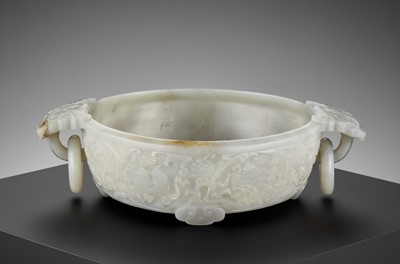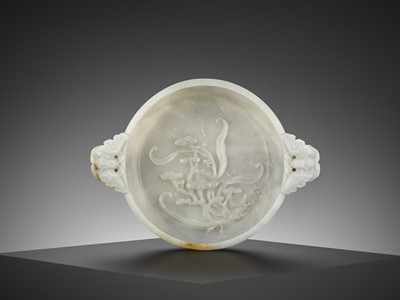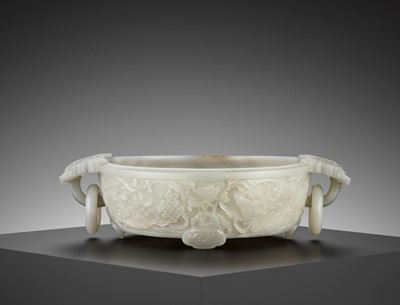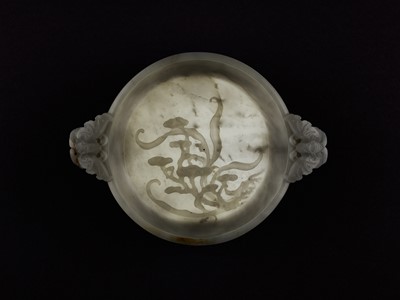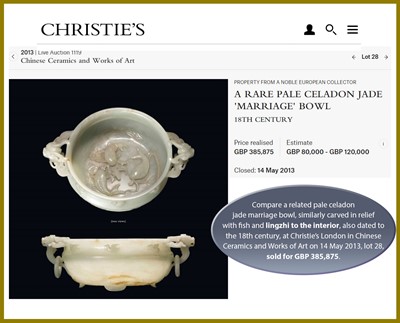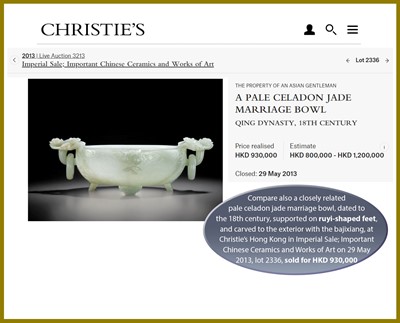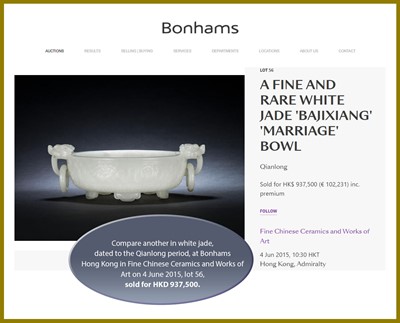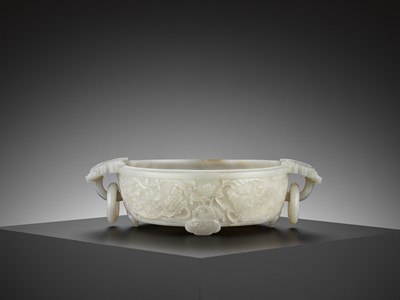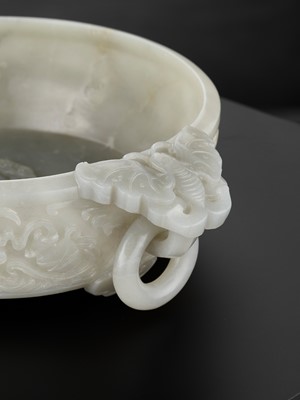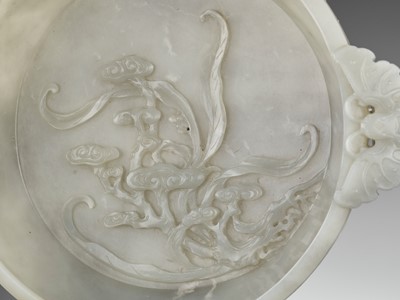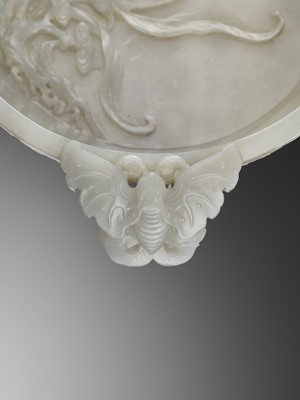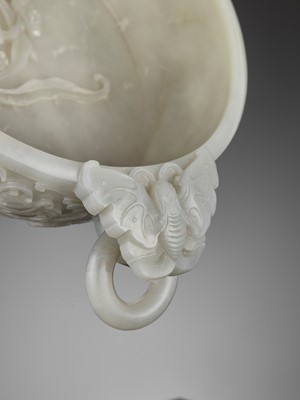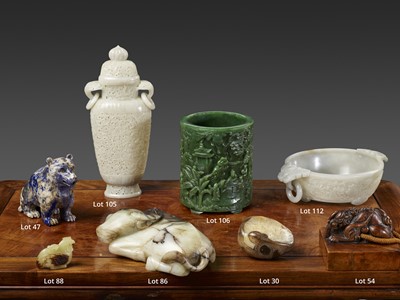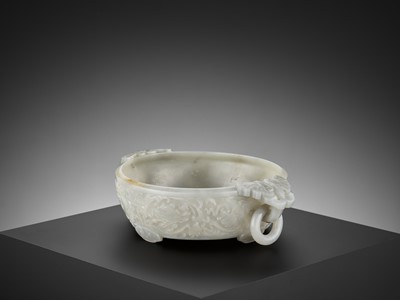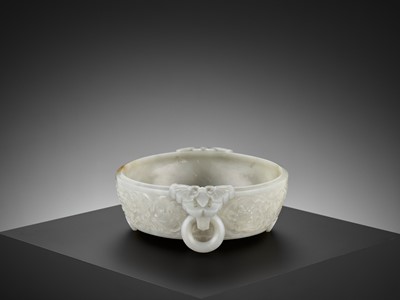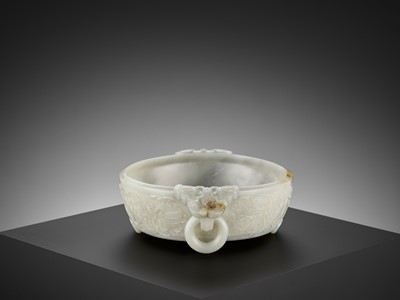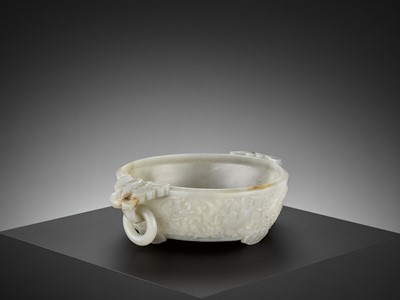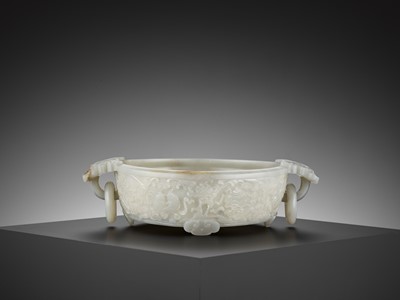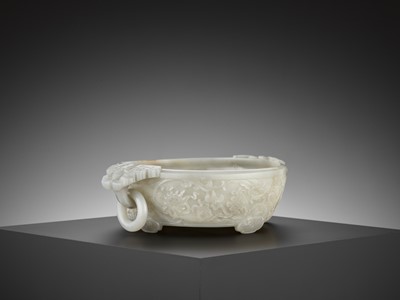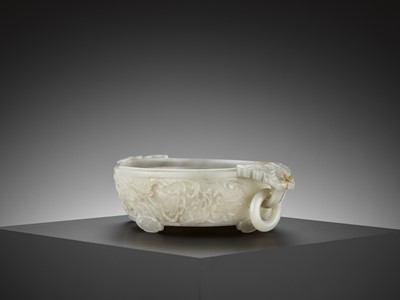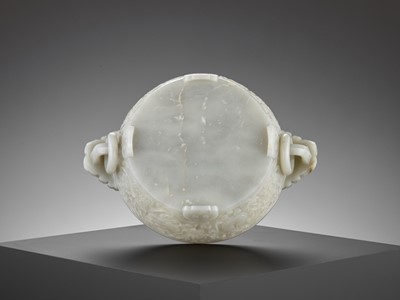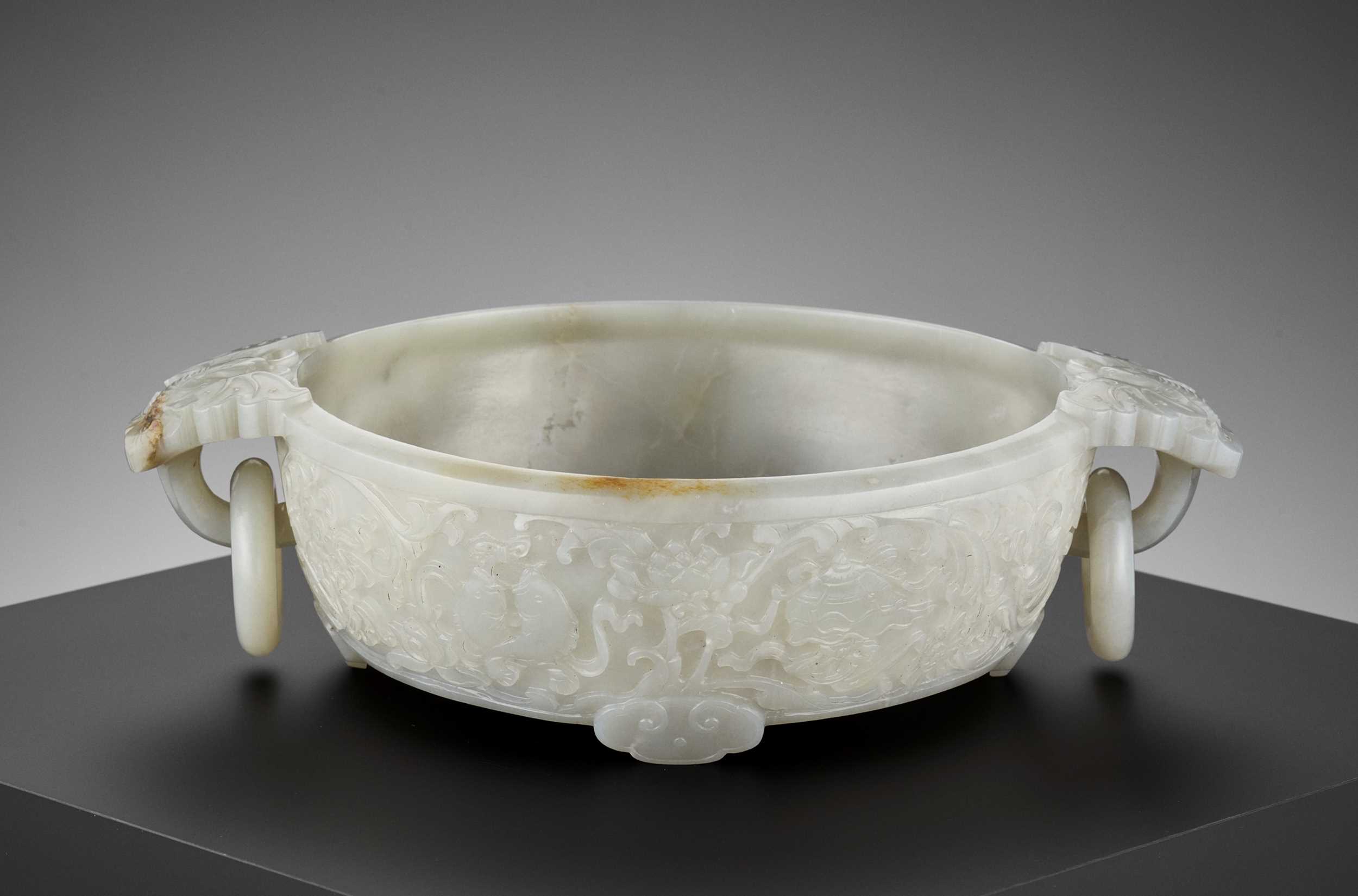15th Oct, 2021 10:00
TWO-DAY AUCTION - Fine Chinese Art / 中國藝術集珍 / Buddhism & Hinduism
112
A RARE ‘BAJIXIANG’ PALE CELADON JADE MARRIAGE BOWL, MID-QING
清代中期罕見八吉祥紋蝴蝶耳活環青白玉洗
Sold for €30,336
including Buyer's Premium
China, 18th century. The interior boldly carved in relief with lingzhi and long, elegantly curved leaves. The deep rounded sides carved to the exterior with the Eight Auspicious Symbols of Buddhism (bajixiang) alternating with lotus sprays. The bowl is supported on four ruyi-shaped feet, the handles issuing from butterflies suspending foliate rings. The translucent stone is of a pale celadon tone with few russet and cloudy white inclusions.
Provenance: The property of a Lady in Scotland, United Kingdom.
Condition: Excellent condition with minor wear. The stone with natural fissures, some of which may have developed into small hairline cracks over time.
Weight: 958.8 g
Dimensions: Width 24.5 cm (across handles)
This fine jade bowl with its superbly carved butterfly handles belongs to the category of ‘marriage’ bowls alternatively carved with butterfly, bat, or dragon handles, popular in the Qing dynasty Imperial court. The two butterfly handles suspending loose rings in mirror image symbolize a ‘joyful encounter’ (Xi xiangfeng), and by extension marital happiness. Combined with the auspicious Eight Buddhist Emblems (bajixiang) – Pair of Fish, Victory Banner, Wheel of Dharma, Parasol, Lotus, Endless Knot, Treasure Vase, and Conch Shell – this would have been a particularly fitting present on the event of a wedding celebration.
The present bowl demonstrates the highly skilled craftsmanship achieved at the height of the Qing dynasty, during the celebrated Qianlong reign. This is exemplified in the remarkable carving of the loose ring handles and the evenly spaced Eight Buddhist Emblems on the exterior, finely balancing the symbolic embellishment of the exterior yet successfully allowing the fine quality of the pale celadon jade to show at the same time.
It is likely that the present bowl was carved after the Qianlong emperor's campaign for the pacification of the Dzungars and Xinjiang (1755-1759), as this campaign secured control over the area of Khotan, allowing direct access to greater quantities of larger-sized high quality jade and therefore for the production of generously proportioned carvings and vessels such as the present lot compared to previous periods. The sheer opulence of the present bowl is emphasized by the generous proportions of the well-hollowed interior, and the significant wastage of the prized jade stone in the carving of the flanking loose ring handles, thus creating a spatial depth of form. The four ruyi-shaped supports also raise the bowl, allowing a greater appreciation of the well carved borders and finely balanced suspended rings.
Literature comparison: For a related example of the use of butterfly handles see a white jade censer and cover with four butterfly handles suspending loose rings, illustrated in The Complete Collection of Treasures of the Palace Museum: Jadeware (II), Beijing, 2008, pl. 27. See also a related white jade 'marriage' bowl, Qianlong, illustrated in The Woolf Collection of Chinese Jade, London, 2013, no. 71; and a similar jade 'marriage' bowl, Qianlong, illustrated by Robert Kleiner, Chinese Jades from the Collection of Alan and Simone Hartman, Hong Kong, 1996, no. 88. For related jade 'marriage' bowls from the Qing Court Collection, see Zhen Xinmiao, Compendium of Collections in the Palace Museum: Jade, Qing Dynasty, vol.10, Beijing, 2010, pls. 180, 198 and 205.
Auction result comparison: Compare a related pale celadon jade marriage bowl, similarly carved in relief with fish and lingzhi to the interior, also dated to the 18th century, at Christie’s London in Chinese Ceramics and Works of Art on 14 May 2013, lot 28, sold for GBP 385,875. Compare also a closely related pale celadon jade marriage bowl, dated to the 18th century, supported on ruyi-shaped feet, and carved to the exterior with the bajixiang, at Christie’s Hong Kong in Imperial Sale; Important Chinese Ceramics and Works of Art on 29 May 2013, lot 2336, sold for HKD 930,000, and another in white jade, dated to the Qianlong period, at Bonhams Hong Kong in Fine Chinese Ceramics and Works of Art on 4 June 2015, lot 56, sold for HKD 937,500.
清代中期罕見八吉祥紋蝴蝶耳活環青白玉洗
中國,十八世紀。青白玉質,洗圓身,敞口,底承五如意雲足,器身兩側作蝴蝶耳,耳下有活環。器内精美雕刻修長的葉子和靈芝。器身外壁一周浮雕八吉祥紋。青白玉質自身瑩潤有光澤,局部留皮,有白色絮狀物。
來源:英國蘇格蘭一位女士的收藏。
品相:狀況極好,有輕微磨損。 具有天然脈絡的玉料,隨著時間的推移,可能會發展成細小的裂縫。
重量:958.8 克
尺寸:寬 24.5 厘米 (across handles)
這種雕有精美蝴蝶耳的玉洗屬於清代宮廷流行的“婚”碗,玉洗的耳部由蝴蝶、蝙蝠或龍交替雕刻。兩隻蝴蝶耳下活環,象徵著“喜相逢”,進而像徵著婚姻的幸福美滿。結合八吉祥——寶傘、金魚、法螺、寶瓶、蓮花、盤長、白蓋、法輪,這將是一件特別合適作爲婚禮的器皿。
此玉洗展示了清朝乾隆年間的制玉的高超技藝。這體現於活環和均勻間隔的八寶,雕刻巧妙,同時成功地讓這清白魚的瓷的優良品質得以展現。
現在的碗很可能是乾隆皇帝平定準噶爾和新疆(1755-1759)之後雕刻的,因爲當時大量上等玉料進入宮廷,促進了宮廷玉器的製作生產。更因此可以製作比例較大的雕刻品和器皿。內部鏤空的寬大比例以及在雕刻活環大量珍貴的玉石,強調了當前玉洗的純粹富足。四個如意足,因此可以更好地欣賞雕刻精美的邊框和精美平衡的活環。
文獻比較:一件玉雕蝴蝶白玉香爐,有蓋,蝴蝶耳,活環,可見北京故宮博物館目錄 The Complete Collection of Treasures of the Palace Museum: Jadeware (II), Beijing, 2008, pl. 27.;一件乾隆時期白玉洗見 The Woolf Collection of Chinese Jade, London, 2013, no. 71;乾隆時期相似玉洗見Robert Kleiner, Chinese Jades from the Collection of Alan and Simone Hartman, Hong Kong, 1996, no. 88。還有一件清宮收藏玉洗,見Zhen Xinmiao, Compendium of Collections in the Palace Museum: Jade, Qing Dynasty, vol.10, Beijing, 2010, pls. 180, 198 and 205。
拍賣結果比較:一件十八世紀青白玉洗,内部浮雕魚與靈芝,見倫敦佳士得Chinese Ceramics and Works of Art 2013年5月14日lot 28, 售價GBP 385,875;一件十八世紀青白玉洗,如意形足,外壁八吉祥紋,見香港佳士得 Imperial Sale:Important Chinese Ceramics and Works of Art 2013年5月29日 lot 2336, 售價HKD 930,000;一件乾隆時期白玉洗,見香港邦翰思Fine Chinese Ceramics and Works of Art 2015年6月4日 lot 56, 售價HKD 937,500。
China, 18th century. The interior boldly carved in relief with lingzhi and long, elegantly curved leaves. The deep rounded sides carved to the exterior with the Eight Auspicious Symbols of Buddhism (bajixiang) alternating with lotus sprays. The bowl is supported on four ruyi-shaped feet, the handles issuing from butterflies suspending foliate rings. The translucent stone is of a pale celadon tone with few russet and cloudy white inclusions.
Provenance: The property of a Lady in Scotland, United Kingdom.
Condition: Excellent condition with minor wear. The stone with natural fissures, some of which may have developed into small hairline cracks over time.
Weight: 958.8 g
Dimensions: Width 24.5 cm (across handles)
This fine jade bowl with its superbly carved butterfly handles belongs to the category of ‘marriage’ bowls alternatively carved with butterfly, bat, or dragon handles, popular in the Qing dynasty Imperial court. The two butterfly handles suspending loose rings in mirror image symbolize a ‘joyful encounter’ (Xi xiangfeng), and by extension marital happiness. Combined with the auspicious Eight Buddhist Emblems (bajixiang) – Pair of Fish, Victory Banner, Wheel of Dharma, Parasol, Lotus, Endless Knot, Treasure Vase, and Conch Shell – this would have been a particularly fitting present on the event of a wedding celebration.
The present bowl demonstrates the highly skilled craftsmanship achieved at the height of the Qing dynasty, during the celebrated Qianlong reign. This is exemplified in the remarkable carving of the loose ring handles and the evenly spaced Eight Buddhist Emblems on the exterior, finely balancing the symbolic embellishment of the exterior yet successfully allowing the fine quality of the pale celadon jade to show at the same time.
It is likely that the present bowl was carved after the Qianlong emperor's campaign for the pacification of the Dzungars and Xinjiang (1755-1759), as this campaign secured control over the area of Khotan, allowing direct access to greater quantities of larger-sized high quality jade and therefore for the production of generously proportioned carvings and vessels such as the present lot compared to previous periods. The sheer opulence of the present bowl is emphasized by the generous proportions of the well-hollowed interior, and the significant wastage of the prized jade stone in the carving of the flanking loose ring handles, thus creating a spatial depth of form. The four ruyi-shaped supports also raise the bowl, allowing a greater appreciation of the well carved borders and finely balanced suspended rings.
Literature comparison: For a related example of the use of butterfly handles see a white jade censer and cover with four butterfly handles suspending loose rings, illustrated in The Complete Collection of Treasures of the Palace Museum: Jadeware (II), Beijing, 2008, pl. 27. See also a related white jade 'marriage' bowl, Qianlong, illustrated in The Woolf Collection of Chinese Jade, London, 2013, no. 71; and a similar jade 'marriage' bowl, Qianlong, illustrated by Robert Kleiner, Chinese Jades from the Collection of Alan and Simone Hartman, Hong Kong, 1996, no. 88. For related jade 'marriage' bowls from the Qing Court Collection, see Zhen Xinmiao, Compendium of Collections in the Palace Museum: Jade, Qing Dynasty, vol.10, Beijing, 2010, pls. 180, 198 and 205.
Auction result comparison: Compare a related pale celadon jade marriage bowl, similarly carved in relief with fish and lingzhi to the interior, also dated to the 18th century, at Christie’s London in Chinese Ceramics and Works of Art on 14 May 2013, lot 28, sold for GBP 385,875. Compare also a closely related pale celadon jade marriage bowl, dated to the 18th century, supported on ruyi-shaped feet, and carved to the exterior with the bajixiang, at Christie’s Hong Kong in Imperial Sale; Important Chinese Ceramics and Works of Art on 29 May 2013, lot 2336, sold for HKD 930,000, and another in white jade, dated to the Qianlong period, at Bonhams Hong Kong in Fine Chinese Ceramics and Works of Art on 4 June 2015, lot 56, sold for HKD 937,500.
清代中期罕見八吉祥紋蝴蝶耳活環青白玉洗
中國,十八世紀。青白玉質,洗圓身,敞口,底承五如意雲足,器身兩側作蝴蝶耳,耳下有活環。器内精美雕刻修長的葉子和靈芝。器身外壁一周浮雕八吉祥紋。青白玉質自身瑩潤有光澤,局部留皮,有白色絮狀物。
來源:英國蘇格蘭一位女士的收藏。
品相:狀況極好,有輕微磨損。 具有天然脈絡的玉料,隨著時間的推移,可能會發展成細小的裂縫。
重量:958.8 克
尺寸:寬 24.5 厘米 (across handles)
這種雕有精美蝴蝶耳的玉洗屬於清代宮廷流行的“婚”碗,玉洗的耳部由蝴蝶、蝙蝠或龍交替雕刻。兩隻蝴蝶耳下活環,象徵著“喜相逢”,進而像徵著婚姻的幸福美滿。結合八吉祥——寶傘、金魚、法螺、寶瓶、蓮花、盤長、白蓋、法輪,這將是一件特別合適作爲婚禮的器皿。
此玉洗展示了清朝乾隆年間的制玉的高超技藝。這體現於活環和均勻間隔的八寶,雕刻巧妙,同時成功地讓這清白魚的瓷的優良品質得以展現。
現在的碗很可能是乾隆皇帝平定準噶爾和新疆(1755-1759)之後雕刻的,因爲當時大量上等玉料進入宮廷,促進了宮廷玉器的製作生產。更因此可以製作比例較大的雕刻品和器皿。內部鏤空的寬大比例以及在雕刻活環大量珍貴的玉石,強調了當前玉洗的純粹富足。四個如意足,因此可以更好地欣賞雕刻精美的邊框和精美平衡的活環。
文獻比較:一件玉雕蝴蝶白玉香爐,有蓋,蝴蝶耳,活環,可見北京故宮博物館目錄 The Complete Collection of Treasures of the Palace Museum: Jadeware (II), Beijing, 2008, pl. 27.;一件乾隆時期白玉洗見 The Woolf Collection of Chinese Jade, London, 2013, no. 71;乾隆時期相似玉洗見Robert Kleiner, Chinese Jades from the Collection of Alan and Simone Hartman, Hong Kong, 1996, no. 88。還有一件清宮收藏玉洗,見Zhen Xinmiao, Compendium of Collections in the Palace Museum: Jade, Qing Dynasty, vol.10, Beijing, 2010, pls. 180, 198 and 205。
拍賣結果比較:一件十八世紀青白玉洗,内部浮雕魚與靈芝,見倫敦佳士得Chinese Ceramics and Works of Art 2013年5月14日lot 28, 售價GBP 385,875;一件十八世紀青白玉洗,如意形足,外壁八吉祥紋,見香港佳士得 Imperial Sale:Important Chinese Ceramics and Works of Art 2013年5月29日 lot 2336, 售價HKD 930,000;一件乾隆時期白玉洗,見香港邦翰思Fine Chinese Ceramics and Works of Art 2015年6月4日 lot 56, 售價HKD 937,500。
Zacke Live Online Bidding
Our online bidding platform makes it easier than ever to bid in our auctions! When you bid through our website, you can take advantage of our premium buyer's terms without incurring any additional online bidding surcharges.
To bid live online, you'll need to create an online account. Once your account is created and your identity is verified, you can register to bid in an auction up to 12 hours before the auction begins.
Intended Spend and Bid Limits
When you register to bid in an online auction, you will need to share your intended maximum spending budget for the auction. We will then review your intended spend and set a bid limit for you. Once you have pre-registered for a live online auction, you can see your intended spend and bid limit by going to 'Account Settings' and clicking on 'Live Bidding Registrations'.
Your bid limit will be the maximum amount you can bid during the auction. Your bid limit is for the hammer price and is not affected by the buyer’s premium and VAT. For example, if you have a bid limit of €1,000 and place two winning bids for €300 and €200, then you will only be able to bid €500 for the rest of the auction. If you try to place a bid that is higher than €500, you will not be able to do so.
Online Absentee and Telephone Bids
You can now leave absentee and telephone bids on our website!
Absentee Bidding
Once you've created an account and your identity is verified, you can leave your absentee bid directly on the lot page. We will contact you when your bids have been confirmed.
Telephone Bidding
Once you've created an account and your identity is verified, you can leave telephone bids online. We will contact you when your bids have been confirmed.
Classic Absentee and Telephone Bidding Form
You can still submit absentee and telephone bids by email or fax if you prefer. Simply fill out the Absentee Bidding/Telephone bidding form and return it to us by email at office@zacke.at or by fax at +43 (1) 532 04 52 20. You can download the PDF from our Upcoming Auctions page.
How-To Guides
How to Create Your Personal Zacke Account
How to Register to Bid on Zacke Live
How to Leave Absentee Bids Online
How to Leave Telephone Bids Online
中文版本的操作指南
创建新账号
注册Zacke Live在线直播竞拍(免平台费)
缺席投标和电话投标
Third-Party Bidding
We partner with best-in-class third-party partners to make it easy for you to bid online in the channel of your choice. Please note that if you bid with one of our third-party online partners, then there will be a live bidding surcharge on top of your final purchase price. You can find all of our fees here. Here's a full list of our third-party partners:
- 51 Bid Live
- EpaiLive
- ArtFoxLive
- Invaluable
- LiveAuctioneers
- the-saleroom
- lot-tissimo
- Drouot
Please note that we place different auctions on different platforms. For example, in general, we only place Chinese art auctions on 51 Bid Live.
Bidding in Person
You must register to bid in person and will be assigned a paddle at the auction. Please contact us at office@zacke.at or +43 (1) 532 04 52 for the latest local health and safety guidelines.
